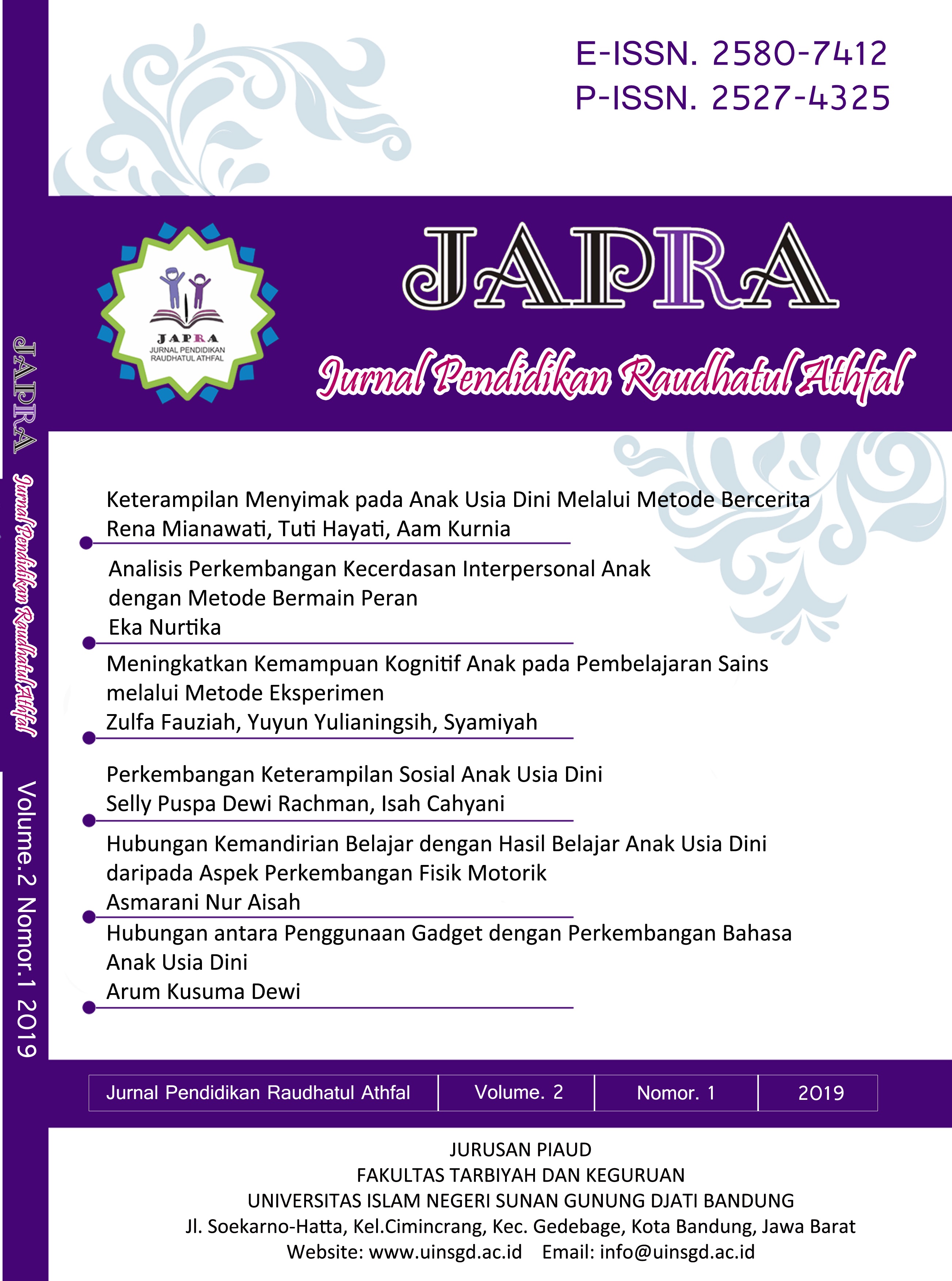Hubungan Antara Kemampuan Berbicara Anak dengan Komunikasi Teman Sebaya
DOI:
https://doi.org/10.15575/japra.v3i1.8103Keywords:
anak usia dini, berbicara, komunikasi, early childhood, speaking, communicationAbstract
This research is motivated by phenomena in the field, including 6 children who have difficulty communicating. These difficulties make communication between peers ineffective. The purpose of this study was to determine the child's speaking ability, child peer communication, the relationship between children's speaking ability and peer communication. The method used is the quantitative correlation. Data collection techniques in this study were through observation, interviews, and documentation. The results of calculations on the variable X obtained an average value of 66 values are at intervals of 60-69 with enough categories. Meanwhile, the Y variable obtained an average value of 65 values are at intervals of 60-69 with enough categories. The relationship between children's ability to speak with peer communication obtained by the correlation coefficient of 0.77. This correlation coefficient number is included in the category of strong / high because it is in the interval 0,600 - 0,799. Significance test results obtained tcount = 434.33 greater than t table = 2.160. This means that Ha is accepted, in other words there is a significant relationship between the child's ability to speak with peer communication. The magnitude of the level of truth of the correlation between children's speaking abilities with peer communication by 36%. This shows that 66% of peer communication is influenced by other factors.References
Afifuddin, B. A. (2012). Metodologi Penelitian Kualitatif. Bandung: Pustaka Setia.
Arikunto, S. (2010). Prosedur Penelitian Suatu Pendekatan Praktik. Jakarta: PT. Rineka Cipta.
Cecep Wahyu Hoerudin, E. K. (2011). KAIDAH DAN PELATIHAN BAHASA INDONESIA (Bahan Pelajaran MKU Bahasa Indonesia). Bandung: CV. Insan Mandiri.
Depsiknas. (2003). Kamus Besar Bahasa Indonesia. Jakarta: Balai Pustaka.
Dhienie, d. (2008). Metode Pengembangan Prilaku dan Kemampuan Dasar Anak Usia Dini. Jakarta: Universitas Terbuka.
Enah Suminah, Y. S. (2015). Pedoman Penilaian Pembelajaran Pendidikan Anak Usia Dini. Jakarta: Direktorat Pembinaan Pendidikan Anak Usia Dini.
Hayati, T. (2014). Pengantar Statistika Pendidikan. Bandung: Insan Mandiri.
Ranggiasanka, A. (2011). Serba-Serbi Pendidikan Anak. Yogyakarta: Hanggar Kreator.
Sugiyo. (2005). Komunikasi Antar Pribadi. Semarang: UNNES Press.
Sugiyono. (2010). Metode Penelitian Pendidikan (Cetakan ke 10) . Bandung: Alfabeta.
Suhada, I. (2016). Psikologi Perkembangan. Bandung.
Sujiono. (2013). konsep Dasar Pendidikan Anak Usia Dini. Jakarta: Indeks.
Sukmadinata, N. S. (2005). Metode Penelitian Pendidikan . Bandung: Remaja Rosdakarya.
Widjaja. (2000). Ilmu Komunikasi Pengantar Studi. Jakarta: Rineka Cipta.
Yusuf, S. (2011). Perkembangan Peserta Didik. Depok: Rajawali Press.
Downloads
Published
Issue
Section
License
Authors who publish with this journal agree to the following terms:
- Authors retain copyright and grant the journal right of first publication with the work simultaneously licensed under a Attribution-ShareAlike 4.0 International (CC BY-SA 4.0) License that allows others to share the work with an acknowledgment of the work's authorship and initial publication in this journal.
- Authors are able to enter into separate, additional contractual arrangements for the non-exclusive distribution of the journal's published version of the work (e.g., post it to an institutional repository or publish it in a book), with an acknowledgment of its initial publication in this journal.
- Authors are permitted and encouraged to post their work online (e.g., in institutional repositories or on their website) prior to and during the submission process, as it can lead to productive exchanges, as well as earlier and greater citation of published work (See The Effect of Open Access).
